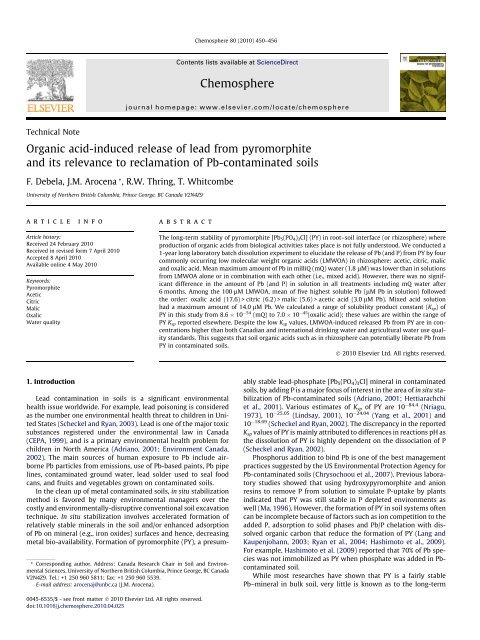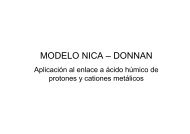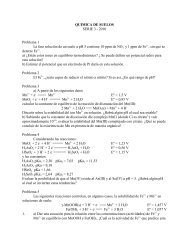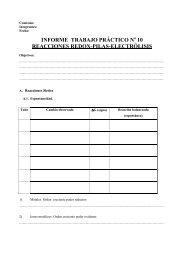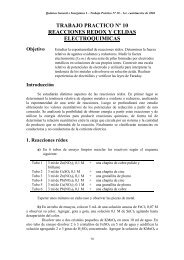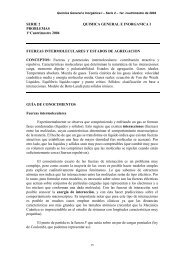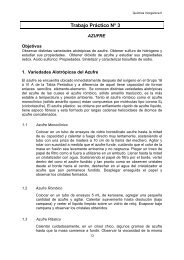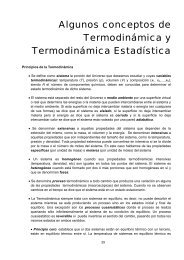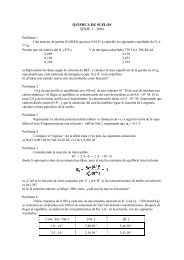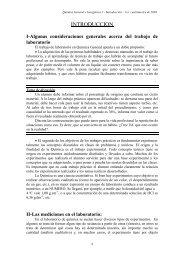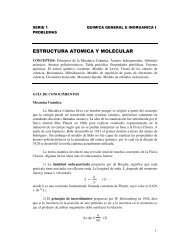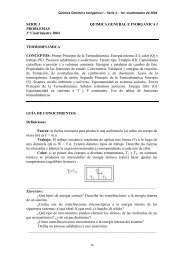Organic acid-induced release of lead from pyromorphite and its ...
Organic acid-induced release of lead from pyromorphite and its ...
Organic acid-induced release of lead from pyromorphite and its ...
Create successful ePaper yourself
Turn your PDF publications into a flip-book with our unique Google optimized e-Paper software.
Chemosphere 80 (2010) 450–456Contents lists available at ScienceDirectChemospherejournal homepage: www.elsevier.com/locate/chemosphereTechnical Note<strong>Organic</strong> <strong>acid</strong>-<strong>induced</strong> <strong>release</strong> <strong>of</strong> <strong>lead</strong> <strong>from</strong> <strong>pyromorphite</strong><strong>and</strong> <strong>its</strong> relevance to reclamation <strong>of</strong> Pb-contaminated soilsF. Debela, J.M. Arocena * , R.W. Thring, T. WhitcombeUniversity <strong>of</strong> Northern British Columbia, Prince George, BC Canada V2N4Z9articleinfoabstractArticle history:Received 24 February 2010Received in revised form 7 April 2010Accepted 8 April 2010Available online 4 May 2010Keywords:PyromorphiteAceticCitricMalicOxalicWater qualityThe long-term stability <strong>of</strong> <strong>pyromorphite</strong> [Pb 5 (PO 4 ) 3 Cl] (PY) in root–soil interface (or rhizosphere) whereproduction <strong>of</strong> organic <strong>acid</strong>s <strong>from</strong> biological activities takes place is not fully understood. We conducted a1-year long laboratory batch dissolution experiment to elucidate the <strong>release</strong> <strong>of</strong> Pb (<strong>and</strong> P) <strong>from</strong> PY by fourcommonly occurring low molecular weight organic <strong>acid</strong>s (LMWOA) in rhizosphere: acetic, citric, malic<strong>and</strong> oxalic <strong>acid</strong>. Mean maximum amount <strong>of</strong> Pb in milliQ (mQ) water (1.8 lM) was lower than in solutions<strong>from</strong> LMWOA alone or in combination with each other (i.e., mixed <strong>acid</strong>). However, there was no significantdifference in the amount <strong>of</strong> Pb (<strong>and</strong> P) in solution in all treatments including mQ water after6 months. Among the 100 lM LMWOA, mean <strong>of</strong> five highest soluble Pb (lM Pb in solution) followedthe order: oxalic <strong>acid</strong> (17.6) > citric (6.2) > malic (5.6) > acetic <strong>acid</strong> (3.0 lM Pb). Mixed <strong>acid</strong> solutionhad a maximum amount <strong>of</strong> 14.0 lM Pb. We calculated a range <strong>of</strong> solubility product constant (K sp )<strong>of</strong>PY in this study <strong>from</strong> 8.6 10 54 (mQ) to 7.0 10 45 (oxalic <strong>acid</strong>); these values are within the range <strong>of</strong>PY K sp reported elsewhere. Despite the low K sp values, LMWOA-<strong>induced</strong> <strong>release</strong>d Pb <strong>from</strong> PY are in concentrationshigher than both Canadian <strong>and</strong> international drinking water <strong>and</strong> agricultural water use qualityst<strong>and</strong>ards. This suggests that soil organic <strong>acid</strong>s such as in rhizosphere can potentially liberate Pb <strong>from</strong>PY in contaminated soils.Ó 2010 Elsevier Ltd. All rights reserved.1. Introduction* Corresponding author. Address: Canada Research Chair in Soil <strong>and</strong> EnvironmentalSciences, University <strong>of</strong> Northern British Columbia, Prince George, BC CanadaV2N4Z9. Tel.: +1 250 960 5811; fax: +1 250 960 5539.E-mail address: arocenaj@unbc.ca (J.M. Arocena).Lead contamination in soils is a significant environmentalhealth issue worldwide. For example, <strong>lead</strong> poisoning is consideredas the number one environmental health threat to children in UnitedStates (Scheckel <strong>and</strong> Ryan, 2003). Lead is one <strong>of</strong> the major toxicsubstances registered under the environmental law in Canada(CEPA, 1999), <strong>and</strong> is a primary environmental health problem forchildren in North America (Adriano, 2001; Environment Canada,2002). The main sources <strong>of</strong> human exposure to Pb include airbornePb particles <strong>from</strong> emissions, use <strong>of</strong> Pb-based paints, Pb pipelines, contaminated ground water, <strong>lead</strong> solder used to seal foodcans, <strong>and</strong> fru<strong>its</strong> <strong>and</strong> vegetables grown on contaminated soils.In the clean up <strong>of</strong> metal contaminated soils, in situ stabilizationmethod is favored by many environmental managers over thecostly <strong>and</strong> environmentally-disruptive conventional soil excavationtechnique. In situ stabilization involves accelerated formation <strong>of</strong>relatively stable minerals in the soil <strong>and</strong>/or enhanced adsorption<strong>of</strong> Pb on mineral (e.g., iron oxides) surfaces <strong>and</strong> hence, decreasingmetal bio-availability. Formation <strong>of</strong> <strong>pyromorphite</strong> (PY), a presumablystable <strong>lead</strong>-phosphate [Pb 5 (PO 4 ) 3 Cl] mineral in contaminatedsoils, by adding P is a major focus <strong>of</strong> interest in the area <strong>of</strong> in situ stabilization<strong>of</strong> Pb-contaminated soils (Adriano, 2001; Hettiarachchiet al., 2001). Various estimates <strong>of</strong> K sp <strong>of</strong> PY are 10 84.4 (Nriagu,1973), 10 25.05 (Lindsay, 2001), 10 24.04 (Yang et al., 2001) <strong>and</strong>10 18.69 (Scheckel <strong>and</strong> Ryan, 2002). The discrepancy in the reportedK sp values <strong>of</strong> PY is mainly attributed to differences in reactions pH asthe dissolution <strong>of</strong> PY is highly dependent on the dissociation <strong>of</strong> P(Scheckel <strong>and</strong> Ryan, 2002).Phosphorus addition to bind Pb is one <strong>of</strong> the best managementpractices suggested by the US Environmental Protection Agency forPb-contaminated soils (Chrysochoou et al., 2007). Previous laboratorystudies showed that using hydroxy<strong>pyromorphite</strong> <strong>and</strong> anionresins to remove P <strong>from</strong> solution to simulate P-uptake by plantsindicated that PY was still stable in P depleted environments aswell (Ma, 1996). However, the formation <strong>of</strong> PY in soil systems <strong>of</strong>tencan be incomplete because <strong>of</strong> factors such as ion competition to theadded P, adsorption to solid phases <strong>and</strong> Pb/P chelation with dissolvedorganic carbon that reduce the formation <strong>of</strong> PY (Lang <strong>and</strong>Kaupenjohann, 2003; Ryan et al., 2004; Hashimoto et al., 2009).For example, Hashimoto et al. (2009) reported that 70% <strong>of</strong> Pb specieswas not immobilized as PY when phosphate was added in Pbcontaminatedsoil.While most researches have shown that PY is a fairly stablePb–mineral in bulk soil, very little is known as to the long-term0045-6535/$ - see front matter Ó 2010 Elsevier Ltd. All rights reserved.doi:10.1016/j.chemosphere.2010.04.025
F. Debela et al. / Chemosphere 80 (2010) 450–456 451stability in the rhizosphere zone (or root-soil interface) where intenseinteractions between PY with roots, soil minerals, microbes,<strong>and</strong> root exudates including low molecular weight organic <strong>acid</strong>s(LMWOA) are expected (Scheckel <strong>and</strong> Ryan, 2002; Zwonitzeret al., 2003; Adriano et al., 2004). Aspergillus niger, an organic-<strong>acid</strong>producing fungus, can dissolve PY while rye grass can take up P<strong>and</strong> Pb <strong>from</strong> PY if it is the sole source <strong>of</strong> P (Sayer et al., 1999). Oxalic<strong>acid</strong> produced by fungi promotes efficient lig<strong>and</strong>-promoted Pbmobilization (Fomina et al., 2004). The concentrations <strong>of</strong> LMWOAin rhizosphere soil are considered to be significantly higher thanin bulk soil solution (Shen et al., 1996; Jones, 1998; Strobel,2001). While Jones (1998) has suggested 10–100 lM soil solutionas a realistic estimate for the concentration <strong>of</strong> most LMWOA inthe rhizosphere soil, other workers have reported as low as 0.9nM oxalic <strong>acid</strong> (Tuason <strong>and</strong> Arocena, 2009) to as high as 4.7 mMcitric <strong>acid</strong> (Dinkelaker et al., 1989). Cao et al. (2002) reported thatcontinuous P consumption by plants may cause decomposition <strong>of</strong>the pre-formed Pb-P minerals. However, there is inadequate researchto demonstrate the long-term stability <strong>of</strong> PY under continuousplant growth. Current knowledge on the fate Pb (<strong>and</strong> P)immobilized as PY in the rhizosphere region is also limited <strong>and</strong>inconclusive.This study was conducted to underst<strong>and</strong> the behavior <strong>of</strong> PY inrhizosphere soils when subjected to various LMWOA commonlyfoundin root-soil interface. In particular, the objective <strong>of</strong> this workwas to compare the <strong>release</strong> <strong>of</strong> Pb (<strong>and</strong> P) <strong>from</strong> synthetic PY in laboratoryconditions when subjected to, acetic, citric, malic <strong>and</strong> oxalic<strong>acid</strong>s at concentrations expected in soils to simulate the fate <strong>of</strong>immobilized Pb (<strong>and</strong> P) in rhizosphere soils. These LMWOAs werejudiciously selected because <strong>of</strong> their ubiquity in soil systems (Ryanet al., 2001; Jones et al., 2003). We discussed the implications <strong>of</strong> Pb(<strong>and</strong> P) <strong>release</strong> with respect to remediation <strong>of</strong> Pb-contaminatedsoils.2. Materials <strong>and</strong> methods2.1. Synthesis <strong>of</strong> <strong>pyromorphite</strong>PY was synthesized under ambient laboratory conditions followingthe method by Scheckel <strong>and</strong> Ryan (2002). PY was obtainedby reacting 0.5 M Pb(NO 3 ) 2 with 0.3 M H 3 PO 4 <strong>and</strong> 0.1 M NaCl solutionin a 4-L beaker. The solution was continuously mixed whilethe phosphoric <strong>acid</strong> was added slowly to the Pb(NO 3 ) 2 <strong>and</strong> NaClsolution. Nitrogen purging to minimize the formation <strong>of</strong> PbCO 3as suggested in the previous method was not necessary here because<strong>lead</strong> carbonate will transform to PY in the presence <strong>of</strong> availablephosphorous (Zhang <strong>and</strong> Ryan, 1999; Melamed et al., 2003).The formation <strong>of</strong> PY was almost instant where a white precipitateformed while the phosphoric <strong>acid</strong> was added. The reaction productwas left to age for 3 d <strong>and</strong> the precipitated PY was collected by centrifugation.The aging process was considered sufficient for the dissolutionreaction as previous work demonstrated that there was nosignificant difference in dissolution pattern between PY aged <strong>from</strong>1 d to 1 year (Scheckel <strong>and</strong> Ryan, 2002). The residual PY was furtherwashed several times with milliQ (mQ) water to remove anyunreacted excess Pb, P, <strong>and</strong> Cl. The final washed product wasfreeze-dried <strong>and</strong> stored in 4 °C until used in the dissolutionexperiments.2.2. Characterization <strong>of</strong> synthetic <strong>pyromorphite</strong>Chemical purity <strong>of</strong> the synthesized PY was determined by elementalanalysis using inductively coupled plasma mass spectroscopy(ICP-MS) after total <strong>acid</strong> microwave digestion procedure.Powder XRD investigation <strong>of</strong> the synthesized PY was conductedusing a Bruker D8 Discover with GADDS system with Co Ka radiationgenerated at 40 kV <strong>and</strong> 20 mA. Integrated EVA s<strong>of</strong>tware(SOCABIM, 2001) was used to calculate major XRD peaks to establishthe mineral identity <strong>of</strong> the synthetic materials. A similar procedurewas applied to the residual materials collected at the end<strong>of</strong> dissolution experiments to underst<strong>and</strong> any crystal alteration <strong>of</strong>PY due to organic <strong>acid</strong>s. The surface morphology <strong>of</strong> synthetic PYbefore <strong>and</strong> after dissolution was studied under a Philips XLS 30Scanning Electron Microscope (SEM).2.3. Batch dissolution <strong>of</strong> <strong>pyromorphite</strong> with organic <strong>acid</strong>sPrior to the dissolution experiments, a 10-d pre-weathering <strong>of</strong>PY was conducted in mQ water to remove ultra fine particles thatmay influence the rates <strong>of</strong> dissolution patterns (Robarge, 1999;Zhang <strong>and</strong> Bloom, 1999). Batch dissolution <strong>of</strong> PY was conductedusing 100 <strong>and</strong> 50 lM <strong>of</strong> acetic, citric, malic <strong>and</strong> oxalic <strong>acid</strong>s for aperiod <strong>of</strong> 1 year. A 50 lM mixed <strong>acid</strong> treatment was also includedto mimic the effects <strong>of</strong> the coexistence <strong>of</strong> these <strong>acid</strong>s in the naturalenvironment <strong>and</strong> dissolution in mQ was used as control. TheLMWOA solutions were prepared in a 0.01 M NaNO 3 solution asbackground electrolyte <strong>and</strong> four drops <strong>of</strong> chlor<strong>of</strong>orm was addedto prevent microbial degradation <strong>of</strong> the organic <strong>acid</strong>s. Initial pHvalues <strong>of</strong> solutions used in the dissolution reaction were:mQ = 5.7, oxalic (100 lM = 3.9, 50 lM = 4.1), citric (100 lM = 4.0,50 lM = 4.4), acetic (100 lM = 4.5, 50 lM = 4.9), malic (100 lM=4.1, 50 lM = 4.5) <strong>and</strong> 50 lM mixed <strong>acid</strong> = 3.6. A major pH changewas not expected between initial <strong>and</strong> final pH <strong>of</strong> the solutions(Scheckel <strong>and</strong> Ryan, 2002).We used <strong>acid</strong> washed 40 mL high-density polyethylene centrifugetubes into which 0.3 g <strong>of</strong> the 10-d pre-weathered PY <strong>and</strong>30 mL <strong>of</strong> mQ or <strong>acid</strong>s were added. The experiment was conductedat ambient room temperature <strong>and</strong> pressure conditions (20 °C <strong>and</strong>101.3 kPa). The tubes were kept in covered boxes to minimizelight, <strong>and</strong> mixtures were gently shaken on a horizontal shaker for2 h weekly (or proportionate periods for short-term dissolutiontimes) <strong>and</strong> just before the end <strong>of</strong> the experiment. At the end <strong>of</strong> eachdissolution period, which ranged <strong>from</strong> 30 min to 1 year, tubes werecentrifuged at high speed (10 4 rpm) for 10 min <strong>and</strong> the clear supernatantwas then carefully filtered using Whatman # 42 filter paper.Supernatant solutions were <strong>acid</strong>ified with 2% HNO 3 <strong>and</strong> stored at4 °C for analysis. Pb <strong>and</strong> P in solution were determined by ICP-MS method. The residual PY at the end <strong>of</strong> the dissolution experimentwas washed five times with mQ water, freeze-dried <strong>and</strong> analyzedusing XRD <strong>and</strong> SEM for any mineral alterations <strong>and</strong>/ormorphological changes.2.4. Statistical analysisStatistical analysis (ANOVA) was conducted to compare the dissolution<strong>of</strong> PY in mQ water <strong>and</strong> LMWOA using the five highest concentrations<strong>of</strong> Pb <strong>and</strong> P in mQ water <strong>and</strong> four <strong>acid</strong>s. These valueswere selected to represent the highest potential for the dissolution(or mobilization) <strong>of</strong> Pb (<strong>and</strong> P) <strong>from</strong> PY by LMWOA at concentrationsused in the experiment.3. Results3.1. Identity <strong>and</strong> morphology <strong>of</strong> synthetic <strong>pyromorphite</strong>Lead <strong>and</strong> P contents showed stoichiometric ratio (Pb:P) <strong>of</strong> 1.67<strong>and</strong> confirmed the chemical purity <strong>of</strong> the synthesized PY. Scanningelectron micrographs <strong>and</strong> X-ray diffractograms revealed that syntheticmaterial was mono-mineralic PY with small (0.5–1.0 lm)tabular <strong>and</strong> columnar morphology that tends to aggregate into a
452 F. Debela et al. / Chemosphere 80 (2010) 450–456large (2.0–6.0 lm) reniform (i.e., kidney-like) crystal habit(Fig. 1a). The strong XRD reflections (in nm) at 0.295, 0.298,0.288, 0.327 <strong>and</strong> 0.412 perfectly matched the diagnostic peaksfor <strong>pyromorphite</strong> (PDF 84-2045) in the PDF-2 Data Base (JCPDS-ICDD, 2001) (Fig. 2). After the 10-d pre-weathering period, we observeda reduction in the amount <strong>of</strong> small-sized PY (Fig. 1b).3.2. Lead in mQ water, 50 <strong>and</strong> 100 lM organic <strong>acid</strong>sabFig. 2. X-ray diffraction patterns <strong>of</strong> the synthetic <strong>pyromorphite</strong> used in the study;the diffractogram matches the recorded XRD peaks for <strong>pyromorphite</strong> PDF 84-2045(JCPDS-ICDD, 2001). There were no detectable changes to <strong>pyromorphite</strong> after 1-yeardissolution experiments with acetic, citric <strong>and</strong> oxalic <strong>acid</strong>s.cFig. 1. Scanning electron micrograph <strong>of</strong> the synthetic <strong>pyromorphite</strong> used in thestudy (a) before, (b) after a 10-d pre-weathering treatment, <strong>and</strong> (c) 6-months aftertreatment with oxalic <strong>acid</strong>.The amount <strong>of</strong> Pb <strong>release</strong>d into solution during the 1-yearbatch dissolution experiments using mQ water <strong>and</strong> LMWOA revealedthe higher amounts <strong>of</strong> Pb in LMWOA compared to mQwater (Fig. 3). Throughout the experiments, Pb in mQ water fluctuated<strong>from</strong> 0.8 to 2.0 lM Pb (mean = 1.4 lM Pb) <strong>and</strong> was lowerthan the four LMWOA alone at 50 <strong>and</strong> 100 lM or in combinationwith each other (i.e., mixed <strong>acid</strong>). Among 100 lM LMWOA, themean <strong>of</strong> the five highest amounts <strong>of</strong> Pb (lM Pb) in solutions followedthe order: oxalic <strong>acid</strong> (17.6) > citric (6.2) > malic (5.6) > acetic<strong>acid</strong> (3.0) (Table 1). The trend in amounts <strong>of</strong> soluble Pb wassimilar for the 50 lM LMWOA treatments although the valueswere less than those extracted at 100 lM LMWOA. The 50 lMmixed <strong>acid</strong> dissolved a maximum amount <strong>of</strong> 14.0 lM Pb(Table1). Soluble Pb in all LMWOA solutions exhibited high concentrationsat early stages <strong>of</strong> dissolution followed by periods <strong>of</strong> low solublePb concentrations comparable to mQ water towards the end<strong>of</strong> the experiments. Mean values for the five maximum soluble Pbcontents observed in 50 lM acetic, citric, malic <strong>and</strong> 100 lM aceticwere higher (but not statistically different) than mQ water (Table1).In all treatments including mQ water, Pb in solution after6 months was not significantly different between the differentsamples. However, concentrations <strong>of</strong> Pb in LMWOA solutions approachedthe values for mQ water at different dissolution periods.Lead in citric, acetic <strong>and</strong> malic <strong>acid</strong>s at 50 <strong>and</strong> 100 lMsolutions were similar to Pb in mQ water after 10 d while Pbin solution intersected the line for mQ water at 30 d <strong>and</strong>6 months for 50 <strong>and</strong> 100 lM oxalic <strong>acid</strong>, respectively (Fig. 3).For the mixed <strong>acid</strong> solution, Pb in solutions was similar to mQwater after 120 d.
F. Debela et al. / Chemosphere 80 (2010) 450–456 453Fig. 3. Soluble Pb in mQ water <strong>and</strong> 50 <strong>and</strong> 100 lM solutions <strong>of</strong> oxalic, citric, acetic <strong>and</strong> malic <strong>acid</strong>s during the 1-year dissolution period. DWG = Drinking Water Guideline.Table 1Mean (<strong>and</strong> SE) maximum soluble Pb <strong>and</strong> P (lM) in mQ water <strong>and</strong> four low molecular weight organic <strong>acid</strong>s at 50 lM <strong>and</strong> 100 lM concentrations.mQ water Acetic Citric Malic Oxalic MixedLead (lM Pb)mQ 1.8 (0.5)a – – – –50 lM – 2.0 (0.3)a 3.3 (0.5)a 3.3 (0.3)a 8.6 (0.7)b 14.0 (1.2)c100 lM – 3.0 (0.2)a,d 6.2 (0.8)d 5.6 (0.6)d 17.6 (1.9)e –Phosphorus (lM P)mQ 1.1 (0.3)a – – – – –50 lM – 2.9 (0.6)a 11.4 (1.1)c 5.8 (0.7)b,d 11.4 (0.9)c 19.6 (1.9)e100 lM – 4.0 (0.6)b 12.7 (1.4)c 8.1 (0.7)d 21.9 (1.0)e –Molar Ratio (Pb:P)mQ 1.650 lM – 0.7 0.3 0.6 0.8 0.7100 lM – 0.8 0.5 0.7 0.8 –For each element, means followed by same letters are not significantly different (p > 0.05).
454 F. Debela et al. / Chemosphere 80 (2010) 450–4563.3. Phosphorus in water <strong>and</strong> 50 <strong>and</strong> 100 lM organic <strong>acid</strong>sSoluble P in mQ water <strong>and</strong> solutions <strong>of</strong> LMWOA throughout thedissolution experiments ranged <strong>from</strong> mixed <strong>acid</strong> (19.6) > 100 lM citric (12.7) > 50 lM oxalic= 50 lM citric (11.4) > 100 lM malic (8.1) > 50 lM malic(5.8) > 100 lM acetic (4.0) > 50 lM acetic (2.9) (Table 1). <strong>Organic</strong><strong>acid</strong>s consistently contained higher soluble P than mQ treatmentup to a certain extraction time period (30 d to 6 months) dependingon LMWOA. The time periods to attain similar concentrations<strong>of</strong> soluble P between LMWOA <strong>and</strong> mQ water were: 10 d for acetic,citric <strong>and</strong> malic at both 50 <strong>and</strong> 100 lM solutions, <strong>and</strong> 30 <strong>and</strong>180 d for oxalic <strong>acid</strong> at 50 <strong>and</strong> 100 lM solutions, respectively. Inaddition, soluble P liberated by the mixed <strong>acid</strong> solution was comparableto the sum <strong>of</strong> individual <strong>acid</strong>s.3.4. Changes to mineral composition <strong>and</strong> morphology <strong>of</strong> <strong>pyromorphite</strong>after 1-year dissolutionWe could not detect any change to the mineral, morphological<strong>and</strong> surficial properties <strong>of</strong> PY after the 1-year dissolution periodusing XRD <strong>and</strong> SEM techniques. The PY still exhibited the reniformcrystal habit for all LMWOA <strong>and</strong> mQ treatments (Fig. 1b <strong>and</strong> c) <strong>and</strong>X-ray diffractograms were not different to PDF 84-045 identifiedearlier as the starting material at the beginning <strong>of</strong> the experiment(Fig. 2).4. Discussion4.1. Dissolution <strong>of</strong> <strong>pyromorphite</strong> in mQ water <strong>and</strong> LMWOASoluble Pb (0.8–2.0 lM Pb) in mQ water during the duration <strong>of</strong> a1-year dissolution experiments is in agreement with Nriagu (1973)who reported soluble Pb concentrations <strong>from</strong> 0.965 to 1.090 lMtotal Pb in water in equilibrium with PY. Others reported a range<strong>of</strong> values <strong>from</strong> a low 183 lM Pb at pH 6.0 to as high as 1.8 mMPb at pH 2.0 in HNO 3 solution (Scheckel <strong>and</strong> Ryan, 2002). Differencesin solubility <strong>of</strong> PY at various pH are due to pH-regulated dissociation<strong>of</strong> H 3 PO 3 <strong>and</strong> eventually the K sp for PY (Scheckel <strong>and</strong>Ryan, 2002). Using a simplified Eq. 1 to describe the stoichiometricdissolution <strong>of</strong> PY in mQ water <strong>and</strong> with the assumption that [Pb 2+ ]equals the measured soluble Pb, then the K sp <strong>of</strong> PY used in thisstudy is 8.6 10 54 . Previously reported K sp lies between 10 18.69(Scheckel <strong>and</strong> Ryan, 2002) <strong>and</strong> 10 84.4 (Nriagu, 1973).Again using Eq. 1 <strong>and</strong> assumptions similar to above calculations,we estimated the dissolution <strong>of</strong> PY in each LMWOA at 100 <strong>and</strong>50 lM, respectively as follows: 8.5 10 52 <strong>and</strong> 2.2 10 53 (acetic),5.8 10 49 <strong>and</strong> 2.0 10 51 (citric), 2.3 10 49 <strong>and</strong>2.0 10 51 (malic), <strong>and</strong> 7.0 10 45 <strong>and</strong> 1.1 10 47 (oxalic).Pb 5 ðPO 4 Þ 3Cl () 5Pb 2þ þ 3PO 3 4þ Cl ð1ÞThe high amounts <strong>of</strong> Pb <strong>release</strong>d by LMWOA especially in theearly stage <strong>of</strong> dissolution can be attributed to the ability <strong>of</strong> organic<strong>acid</strong>s to chelate metals. Chelate formation is chemically favoredbecause it increases the entropy by displacing the hydration shellsaround the metal ion (i.e., Pb 2+ )(McBride, 1994). <strong>Organic</strong> <strong>acid</strong>ssupply both protons <strong>and</strong> metal complexing anions to mobilize metalions (e.g., Pb 2+ ) <strong>and</strong> facilitate mineral weathering (e.g., <strong>pyromorphite</strong>)(Shen et al., 1996; Jones, 1998; Banfield et al., 1999;Strobel, 2001; Jarosz-Wilkolazka <strong>and</strong> Gadd, 2003; Jones et al.,2003; Gadd, 2004). Drever <strong>and</strong> Stillings (1997) proposed at leastthree mechanisms by which LMWOA governs mineral breakdownin soils: (1) to induce dissolution rate by decreasing solution pHor forming surface complexes through adsorption on mineral surfaces;(2) to alter saturation state <strong>of</strong> the solution with respect tominerals; <strong>and</strong> (3) to influence speciation <strong>of</strong> elements in solution.The range in Pb:P molar ratios (1.6 in mQ <strong>and</strong> 0.3–0.8 inLMWOA) suggests that while the dissolution <strong>of</strong> PY in mQ is stoichiometric,other mechanisms control the dissolution in the presence<strong>of</strong> organic <strong>acid</strong>s. We hypothesize that PY in the presence <strong>of</strong>LMWOA initially follows a non-stoichiometric dissolution throughthe formation Pb-organic surface sorption complexes (Drever <strong>and</strong>Stillings, 1997), hence preferentially increasing P in solution. Asthe dissolution progresses, however, dissolution in LMWOA approachesthat <strong>of</strong> mQ (Fig. 3) with higher Pb:P molar ratio (1.2, datanot shown) compared to the initial period. This suggests with timepreviously formed Pb-organic surface complexes may no longerexist, Pb is liberated in solution, <strong>and</strong> the equilibrium is approachingPY in mQ. Although the exact mechanism is not known to usat this time, we believe that the degradation <strong>of</strong> the organic lig<strong>and</strong>swith time is likely to be the responsible for the suspected disappearance<strong>of</strong> Pb-organic complexes.Recently, oxalic <strong>acid</strong> excreted by the fungus Beauveria caledonicahas been reported to form complexes such as Pb-oxalate,Cu-oxalate hydrate <strong>and</strong> Zn-oxalate dihydrate (Fomina et al.,2005). Although surface adsorption <strong>of</strong> Pb <strong>and</strong> formation <strong>of</strong> secondaryPb-mineral are theoretically plausible, XRD <strong>and</strong> SEM data revealedno detectable structural, mineralogical changes to PY aswell as the formation <strong>of</strong> Pb-oxalate throughout the dissolution period;these observations are in agreement with Scheckel <strong>and</strong> Ryan(2002) <strong>and</strong> Xie <strong>and</strong> Giammar (2007).In addition, it seems that the nature (<strong>and</strong> concentration) <strong>of</strong> eachLMWOA results in a different affinity to form surface complexes<strong>and</strong> eventually determines the amount <strong>of</strong> Pb in solution. McBride(1994) described pH as the ‘‘master variable” controlling the metalhydrolysis <strong>and</strong> complexation including chelate formation. In ourstudy, LMWOA solutions with pH < 4.5 had significantly higher solublePb than mQ water (pH = 5.6) <strong>and</strong> LMWOA solutions withpH > 4.5 (100 lM acetic <strong>acid</strong>, <strong>and</strong> 50 lM acetic <strong>and</strong> malic <strong>acid</strong>s).Solution pH strongly influences the activities <strong>of</strong> metal (i.e., Pb 2+ )<strong>and</strong> the de/protonation <strong>of</strong> LMWOA, thus the availability <strong>of</strong> lig<strong>and</strong>s.However, solution pH alone cannot explain the dissolution patternsobserved in this study. For example, 50 lM oxalate <strong>acid</strong> extractedmore Pb than the 100 lM malic <strong>acid</strong> solution at the sameinitial pH. Solution pH may be a contributing factor in the dissolution<strong>of</strong> PY but specific affinity <strong>of</strong> LMWOA for Pb seemed to be a majordriving factor in PY dissolution in this study. In rhizospheresoils, these <strong>acid</strong>s occur simultaneously <strong>and</strong> may synergistically increasePb <strong>release</strong> <strong>from</strong> PY as observed in 50 lM mixed <strong>acid</strong> solutioncompared to individual 50 lM LMWOA solutions.4.2. Implications to the reclamation <strong>of</strong> Pb-contaminated soilsThe continuous production <strong>of</strong> LMWOA in rhizosphere soils willsubject PY to several dissolution reactions that may <strong>lead</strong> to possible<strong>release</strong> <strong>of</strong> Pb into the environment. LMWOA are exuded byplants <strong>and</strong> soil microorganisms during the decomposition <strong>of</strong> organicmatter (e.g., Jones, 1998; Banfield et al., 1999; Sterflinger,2000; Vivanco et al., 2002). Oxalic <strong>and</strong> acetic <strong>acid</strong> are known to occurin soils with higher concentrations in the rhizosphere comparedto bulk soils (e.g., Fox <strong>and</strong> Comerford, 1990; Ryan et al.,2001; Strobel, 2001; Jones et al., 2003; Tuason <strong>and</strong> Arocena,2009). The ubiquity <strong>of</strong> LMWOA in soils will <strong>release</strong> Pb <strong>from</strong> PY athigher concentrations than mQ water as long as soil organismsare active inhabitants <strong>of</strong> the soils.Soluble Pb <strong>release</strong>d in mQ water <strong>and</strong> LMWOA are higher than inboth the Canadian <strong>and</strong> international drinking water quality st<strong>and</strong>ard(0.05 lM Pb) <strong>and</strong> the Canadian guideline for agriculturalwater use (0.48 lM Pb <strong>and</strong> 0.96 lM Pb for livestock <strong>and</strong> for irriga-
F. Debela et al. / Chemosphere 80 (2010) 450–456 455tion water use, respectively) (CCME, 2005; Federal-Provincial-TerritorialCommittee on Drinking, 2008; WHO, 2008). For example,Pb <strong>release</strong>d by 100 lM oxalic <strong>acid</strong> (17.6 lM Pb) > 350 times theCanadian st<strong>and</strong>ard for drinking water while the Pb <strong>release</strong>d in50 lM acetic <strong>acid</strong> >40 times more. Soluble Pb in 50 lM mixed <strong>acid</strong>solution was above the Canadian drinking water quality st<strong>and</strong>ardby a factor <strong>of</strong> at least 250.Other environmental concerns include potential P efflux togroundwater <strong>and</strong> eutrophication <strong>of</strong> water bodies because the Padded to form PY far exceeds amounts typically used for agriculturalpurposes (Singh et al., 2001; Chen et al., 2003; Pierzynski<strong>and</strong> Gehl, 2004). The amounts <strong>of</strong> P <strong>release</strong>d in the LMWOA solutionsare much higher compared to mQ water <strong>and</strong> may potentiallycontribute to eutrophication. However, the high P <strong>release</strong>d in theLMWOA solution may benefit organisms in Pb-contaminated soilsbecause P is one <strong>of</strong> the three major elements needed by plants <strong>and</strong>soil organisms along with N <strong>and</strong> K.Although Pb <strong>and</strong> P are <strong>release</strong>d <strong>from</strong> PY reactions with LMWOA,the environmental fate <strong>of</strong> liberated Pb <strong>and</strong> P is subject to other processesin soils. Soluble Pb <strong>and</strong> P can adsorb on soil colloids (e.g.,negative <strong>and</strong> positive-charged soil organic matter) as well aschemisorb on the surface <strong>of</strong> oxides <strong>and</strong> oxyhydroxides. Researcheshave shown that PY formation in soil can be inhibited by the presence<strong>of</strong> dissolved organic carbon (Lang <strong>and</strong> Kaupenjohann, 2003)<strong>and</strong> organic matter (Hashimoto et al., 2009) through organo-metalcomplex formation. It can be argued that even if LMWOA results inhigher <strong>release</strong> <strong>of</strong> Pb <strong>and</strong> P <strong>from</strong> PY, the fate <strong>of</strong> liberated Pb <strong>and</strong> Pfaces many complex processes (e.g., organo-metal complex formation)before they become bioavailable. In other words, the dissolution<strong>of</strong> PY in natural soil systems <strong>and</strong> particularly in rhizospheresoil is much more complex than it is presented in a batch dissolutionexperiment, <strong>and</strong> therefore, our results are limited to just fewaspects <strong>of</strong> many complex processes in the environment.5. ConclusionsWe conclude that LMWOA are able to <strong>release</strong> more Pb <strong>from</strong> PYthan mQ water alone. One should be aware that under natural soilconditions, more dissolution <strong>of</strong> PY could be expected because severalLMWOA may occur in combination with many more <strong>acid</strong>s(e.g., aromatic <strong>acid</strong>s such as benzoic, p-hydroxybenzoic <strong>and</strong> protocatechuic)which have not been studied here. These <strong>acid</strong>s may havehigher dissociation constants <strong>and</strong> may result in much higher levels<strong>of</strong> soluble Pb 2+ <strong>release</strong>d <strong>from</strong> PY than the LMWOA investigated inthis study. On the other h<strong>and</strong>, because <strong>of</strong> the incomplete underst<strong>and</strong>ing<strong>of</strong> the nature <strong>of</strong> soluble Pb (<strong>and</strong> P) <strong>and</strong> interaction withcomplex solid phases, care should be taken in the interpretations<strong>of</strong> our results to assess the use <strong>of</strong> P amendment in remediationPb-contaminated soils.AcknowledgementsThis research was supported by the Canada Research Chair Program<strong>and</strong> the Natural Sciences <strong>and</strong> Engineering Research Council <strong>of</strong>Canada. We would like to thank A. Esler <strong>and</strong> Q. Wu for their assistancein ICP analyses.ReferenceAdriano, D.C., 2001. Trace Elements in Terrestrial Environments: Biogeochemistry,Bioavailability, <strong>and</strong> Risks <strong>of</strong> Metals, second ed. Springer-Verlag, New York.Adriano, D.C., Wenzel, W.W., Vangronsveld, J., Bolan, N.S., 2004. Role <strong>of</strong> assistednatural remediation in environmental cleanup. Geodrema 122, 121–142.Banfield, J.F., Baker, W.W., Welch, S.A., Taunton, A., 1999. Biological impact onmineral dissolution: application <strong>of</strong> the lichen model to underst<strong>and</strong>ing mineralweathering in the rhizosphere. Proc. Natl. Acad. Sci. USA 96, 3404–3411.Cao, X., Ma, L.Q., Chen, M., Singh, S.P., Harris, W.G., 2002. Impacts <strong>of</strong> phosphateamendments on <strong>lead</strong> biogeochemistry at a contaminated site. Environ. Sci.Technol. 36, 5296–5304.CCME (Canadian Council <strong>of</strong> Ministers <strong>of</strong> the Environment), 2005. Canadian WaterQuality Guidelines for the Protection <strong>of</strong> Agricultural Water Uses: SummaryTable (updated October 2005). Canadian Council <strong>of</strong> Ministers <strong>of</strong> theEnvironment, Winnipeg.CEPA (Canadian Environmental Protection Agency), 1999. Canadian EnvironmentalProtection Act, 1999. Minister <strong>of</strong> Justice (accessed 1.02.10).Chen, M., Ma, L.Q., Singh, S.P., Cao, R.X., Melamed, R., 2003. Field demonstration <strong>of</strong>in situ immobilization <strong>of</strong> soil Pb using P amendments. Adv. Environ. Res. 8, 93–102.Chrysochoou, M., Dermatas, D., Grubb, D.G., 2007. Phosphate application to firingrange soils for Pb immobilization: the unclear role <strong>of</strong> phosphate. J. Hazard.Mater. 144, 1–14.Dinkelaker, B., Romheld, V., Marschner, H., 1989. Citric <strong>acid</strong> excretion <strong>and</strong>precipitation <strong>of</strong> calcium citrate in rhizosphere <strong>of</strong> white lupin (Lupins albus L.).Plant, Cell Environ. 12, 285–292.Drever, J.I., Stillings, L.L., 1997. The role <strong>of</strong> organic <strong>acid</strong>s in mineral weathering.Colloids Surf., A 120, 167–181.Environment Canada, 2002. Children’s Environmental Heath. Envirozine(Environment Canada’s On-line Newsmagazine) Issue 20, Feature 2. (accessed 1.02.10).Federal-Provincial-Territorial Committee on Drinking Water, 2008. Guidelines forCanadian Drinking Water Quality Summary Table. Federal-Provincial-TerritorialCommittee on Health <strong>and</strong> the Environment. (accessed1.02.10).Fomina, M.A., Alex<strong>and</strong>er, I.J., Hillier, S., Gadd, G.M., 2004. Zinc phosphate <strong>and</strong><strong>pyromorphite</strong> solubilization by soil plant-symbiotic fungi. Geomicrobiol. J. 21,351–366.Fomina, M., Hillier, S., Charnock, J.M., Melville, K., Alex<strong>and</strong>er, I.J., Gadd, G.M., 2005.Role <strong>of</strong> oxalic <strong>acid</strong> overexcretion in transformations <strong>of</strong> toxic metal minerals byBeauveria caledonica. Appl. Environ. Microbiol. 71, 371–381.Fox, T.R., Comerford, N.B., 1990. Low-molecular-weight organic <strong>acid</strong>s in selectedforest soils <strong>of</strong> the southeastern USA. Soil Sci. Soc. Am. J. 54, 1139–1144.Gadd, G.M., 2004. Microbial influence on metal mobility <strong>and</strong> application forbioremediation. Geoderma 122, 109–119.Hashimoto, Y.M., Takaoka, M., Oshita, K., Tanida, H., 2009. Incompletetransformations <strong>of</strong> Pb to <strong>pyromorphite</strong> by phosphate-<strong>induced</strong> immobilizationinvestigated by X-ray absorption fine structure (XAFS) spectroscopy.Chemosphere 76, 616–622.Hettiarachchi, G.M., Pierzynski, G.M., Ransom, M.D., 2001. In situ stabilization <strong>of</strong> soil<strong>lead</strong> using phosphorous. J. Environ. Qual. 30, 1214–1221.Jarosz-Wilkolazka, A., Gadd, G.F., 2003. Oxalate production by wood-rotting fungigrowing in toxic metal-amended medium. Chemosphere 52, 541–547.JCPDS-ICDD, 2001. PDF-2 Data Base (Sets 1-51 plus 70-89) JCPDS – InternationalCentre for Diffraction Data. Newtown Square, PA.Jones, D.L., 1998. <strong>Organic</strong> <strong>acid</strong>s in the rhizosphere – a critical review. Plant Soil 205,25–44.Jones, D.L., Dennis, P.G., Owen, A.G., van Hees, P.A.W., 2003. <strong>Organic</strong> <strong>acid</strong> behavior insoils-misconceptions <strong>and</strong> knowledge gaps. Plant Soil 248, 31–41.Lang, F., Kaupenjohann, M., 2003. Effect <strong>of</strong> dissolved organic matter on precipitation<strong>and</strong> mobility <strong>of</strong> the <strong>lead</strong> compound chloro<strong>pyromorphite</strong> in solution. Eur. J. SoilSci. 54, 139–148.Lindsay, W.L., 2001. Chemical Equilibria in Soils, second ed. The Blackburn Press,New Jersey.Ma, L.Q., 1996. Factors influencing the effectiveness <strong>and</strong> stability <strong>of</strong> aqueous <strong>lead</strong>immobilization by hydroxyapatite. J. Environ. Qual. 25, 1420–1429.McBride, M.B., 1994. Environmental Chemistry <strong>of</strong> Soils. Oxford University Press,New York.Melamed, R., Cao, X., Chen, M., Ma, L.Q., 2003. Field assessment <strong>of</strong> <strong>lead</strong>immobilization in a contaminated soil after phosphate application. Sci. TotalEnviron. 305, 117–127.Nriagu, J.O., 1973. Lead orthophosphates-II. Stability <strong>of</strong> chloro<strong>pyromorphite</strong> at 25 C.Geochim. Coscmochim. Acta 37, 367–377.Pierzynski, G.M., Gehl, K.A., 2004. An alternative method for remediating <strong>lead</strong>contaminatedsoils in residential areas: a decision case study. J. Nat. Resour. LifeSci. Ed. 33, 63–69.Robarge, W.P., 1999. Precipitation/dissolution reactions in soils. In: Sparks, D. (Ed.),Soil Physical Chemistry. CRC Press, Boca Raton, pp. 193–238.Ryan, P.R., Delhaize, E., Jones, D.L., 2001. Function <strong>and</strong> mechanism <strong>of</strong> organic anionexudation <strong>from</strong> plant roots. Annu. Rev. Plant Physiol. Plant Mol. Biol. 52, 527–560.Ryan, J.A., Scheckel, K.G., Berti, W.R., Brown, S.L., Casteel, S.W., Chaney, R.L.,Hallfrisch, J., Doolan, M., Grevatt, P., Maddaloni, M., Mosby, D., 2004. Reducingchildren’s risk <strong>from</strong> <strong>lead</strong> in soil. Environ. Sci. Technol. 38, 19A–24A.Sayer, J.A., Cotter-Howells, J.D., Watson, C., Hillier, S., Gadd, G.M., 1999. Leadmineral transformation by fungi. Curr. Biol. 9, 691–694.Scheckel, K.G., Ryan, J.A., 2002. Effects <strong>of</strong> aging <strong>and</strong> pH on dissolution kinetics <strong>and</strong>stability <strong>of</strong> chloro<strong>pyromorphite</strong>. Environ. Sci. Technol. 36, 2198–2204.Scheckel, K.G., Ryan, J.A., 2003. In vitro formation <strong>of</strong> <strong>pyromorphite</strong> via reaction <strong>of</strong> Pbsources with s<strong>of</strong>t-drink phosphoric <strong>acid</strong>. Sci. Total Environ. 302, 253–265.Shen, Y., Strom, L., Jonson, J., Tyler, G., 1996. Low-molecular organic <strong>acid</strong>s in therhizosphere soil solution <strong>of</strong> beech forest (Fagus sylvatica L.) Cambisols
456 F. Debela et al. / Chemosphere 80 (2010) 450–456determined by ion chromatography using supported liquid membraneenrichment technique. Soil Biol. Biochem. 28, 1163–1169.Singh, S.P., Ma, L.Q., Harris, W.G., 2001. Heavy metal interactions withphosphatic clay: sorption <strong>and</strong> desorption behavior. J. Environ. Qual. 30,1961–1968.SOCABIM, 2001. EVA Application 7.01. Bruker AXS, Madison, WI.Sterflinger, K., 2000. Fungi as geologic agents. Geomicrobiol. J. 17, 97–124.Strobel, B.W., 2001. Influence <strong>of</strong> vegetation on low-molecular-weight carboxylic<strong>acid</strong>s in soil solution – a review. Geoderma 99, 169–198.Tuason, M., Arocena, J.M., 2009. Root organic <strong>acid</strong> exudates <strong>and</strong> properties <strong>of</strong>rhizospheres <strong>of</strong> white spruce (Picea glauca) <strong>and</strong> subalpine fir (Abies lasiocarpa).Can. J. Soil Sci. 89, 287–300.Vivanco, J.M., Guimara~ es, R.L., Flores, H.E., 2002. Underground plantmetabolism: the biosynthetic potential <strong>of</strong> roots. In: Waisel, Y., Eshel, A.,Kafkafi, U. (Eds.), Plant Roots: the Hidden Half. Marcel <strong>and</strong> Dekker, NewYork, pp. 1045–1070.WHO (World Health Organization), 2008. Guidelines for Drinking Water Quality.third ed., Incorporating the First <strong>and</strong> Second Agenda. vol. 1, Recommendations.World Health Organization, Geneva.Xie, L., Giammar, D.E., 2007. Equilibrium solubility <strong>and</strong> dissolution rate <strong>of</strong> <strong>lead</strong>phosphate chloro<strong>pyromorphite</strong>. Environ. Sci. Technol. 41, 8050–8055.Yang, J., Mosby, D.E., Casteel, S.W., Blanchar, R.W., 2001. Lead immobilization usingphosphoric <strong>acid</strong> in smelter-contaminated urban soils. Environ. Sci. Technol. 35,3553–3559.Zhang, H., Bloom, P.R., 1999. Dissolution kinetics <strong>of</strong> hornblende in organic <strong>acid</strong>solutions. Soil Sci. Soc. Am. J. 63, 815–822.Zhang, P.C., Ryan, J.A., 1999. Transformation <strong>of</strong> Pb(II) <strong>from</strong> cerrusite tochloro<strong>pyromorphite</strong> in the presence <strong>of</strong> hydroxyapatite under varyingconditions <strong>of</strong> pH. Environ. Sci. Technol. 33, 625–630.Zwonitzer, J., Pierzynski, G.M., Hettiarachchi, G.M., 2003. Effects <strong>of</strong> phosphorousadditions ob <strong>lead</strong>, cadmium, <strong>and</strong> zinc bioavailability in a metal contaminatedsoils. Water, Air, Soil Pollut. 143, 193–209.


